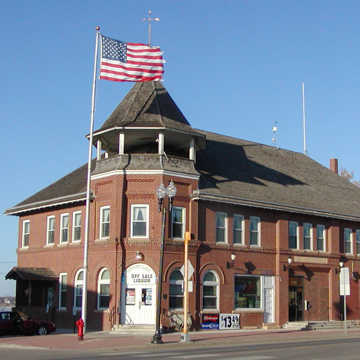In 1878 government surveyors created a city named for the philanthropist John Howard. Located forty-five miles west of the Twin Cities, Howard Lake was home to merchant establishments, hotels, livery stables, grain elevators, a bank, lumberyard, and mill in the late nineteenth century. It had three law firms, four doctors, and seven churches, along with an attractive city hall. The original 1891 city hall was destroyed by fire and on March 8, 1904, the city council issued a 15-year bond for $5,000 to finance a new building on the same site, a full city block directly on the shores of 736-acre Howard Lake.
Built of red Menominee brick and rubble stone foundation, the structure’s late Victorian style featured elements of the Richardsonian Romanesque in its rounded arches over the first-floor doors and windows, along with Queen Anne elements, most notably in the corner tower with an open octagonal balcony on the uppermost or third level under the pointed roof. Decorative brick banding can be found in the string course separating the first and second levels and within the panels on the second story of the tower. A hipped roof, two chimney stacks, and two gabled dormers with Palladian windows complete the ensemble.
The building served many purposes. It housed a post office, public library, 500-seat auditorium, courtroom, council chambers, fire department, public hall, offices, horse barn, and a barber shop. The auditorium, located on the second level, had a stage on the west end and was used for entertainment productions and community get togethers.
City offices relocated in 2005 and the building is currently home to the Municipal Liquor Off-sale store, whose profits help augment the city budget.
References
Gardner, Denis. Minnesota Treasures: Stories Behind the State’s Historic Places. St. Paul: Minnesota Historical Society Press, 2004.
Hackett, John. J. “Howard Lake City Hall,” Wright County, Minnesota. National Historic Properties Inventory Form, 1979. National Register of Historic Places, Washington D.C.






